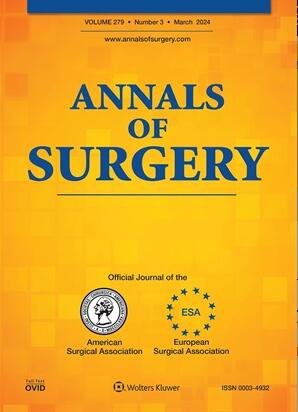标准化右半结肠联合D2淋巴结切除术是否足以限制右半结肠腺癌的局部复发?
IF 6.4
1区 医学
Q1 SURGERY
引用次数: 0
摘要
目的:探讨I-III期右侧结肠癌腹腔镜右半结肠切除术、标准化全肠系膜切除术(CME)和D2淋巴结切除术后局部复发(LR)的肿瘤相关和病理预测因素,并描绘局部和远处复发的不同模式。虽然CME联合中央血管结扎术被提倡改善结肠癌的肿瘤预后,但其真正的影响仍存在争议。大多数证据集中在手术技术和淋巴结的转移,往往低估了肿瘤生物学的作用。此外,标准生存分析不能充分考虑竞争事件,可能会扭曲复发估计。方法回顾性分析2017年至2024年间连续400例行腹腔镜右半结肠CME和D2淋巴结切除术的患者。使用Fine-Gray竞争风险模型评估复发模式,以确定局部和远处复发的独立预测因子。在39个月的中位随访中,只有2.5%的患者发生了LR,而9%的患者发生了远处转移。在所有变量中,只有近端横结肠存在肿瘤与较高的LR风险独立相关(亚分布风险比[sHR] 5.3; P=0.016)。神经周围浸润(sHR 2.74, P=0.019)和晚期淋巴结分期(sHR 5.59, P<0.001)显著预测远处复发。结论标准化CME联合D2淋巴结切除术可确保右侧结肠癌的良好局部控制。然而,近端横结肠肿瘤表现出独特的LR模式。将肿瘤位置和病理危险因素纳入手术计划可以支持更加个性化,生物学驱动的结直肠癌治疗方法。本文章由计算机程序翻译,如有差异,请以英文原文为准。
Is Standardized Right Hemicolectomy with D2 Lymphadenectomy Enough to Limit Local Recurrence in Adenocarcinoma of the Right Colon?
OBJECTIVE
To identify tumor-related and pathological predictors of local recurrence (LR) following laparoscopic right hemicolectomy with standardized complete mesocolic excision (CME) and D2 lymphadenectomy for stage I-III right-sided colon cancer, and to delineate distinct patterns of local versus distant recurrence.
SUMMARY BACKGROUND DATA
While CME with central vascular ligation is advocated to improve oncologic outcomes in colon cancer, its true impact remains controversial. Most evidence focuses on surgical technique and nodal yield, often underestimating the role of tumor biology. Moreover, standard survival analyses fail to adequately account for competing events, potentially skewing recurrence estimates.
METHODS
We retrospectively analyzed 400 consecutive patients who underwent laparoscopic right hemicolectomy with CME and D2 lymphadenectomy between 2017 and 2024. Recurrence patterns were evaluated using Fine-Gray competing risk models to identify independent predictors of local and distant relapse.
RESULTS
With a median follow-up of 39 months, LR occurred in only 2.5% of patients, whereas 9% developed distant metastases. Among all variables, only the presence of a tumor in the proximal transverse colon was independently associated with a higher LR risk (subdistribution hazard ratio[sHR] 5.3; P=0.016). Perineural invasion (sHR 2.74; P=0.019) and advanced nodal stage (sHR 5.59; P<0.001) significantly predicted distant relapse.
CONCLUSIONS
Standardized CME with D2 lymphadenectomy ensures excellent local control in right-sided colon cancer. However, proximal transverse colon tumors exhibit a unique pattern of LR. Incorporating tumor location and pathological risk factors into surgical planning could support a more personalized, biology-driven approach to colorectal cancer treatment.
求助全文
通过发布文献求助,成功后即可免费获取论文全文。
去求助
来源期刊

Annals of surgery
医学-外科
CiteScore
14.40
自引率
4.40%
发文量
687
审稿时长
4 months
期刊介绍:
The Annals of Surgery is a renowned surgery journal, recognized globally for its extensive scholarly references. It serves as a valuable resource for the international medical community by disseminating knowledge regarding important developments in surgical science and practice. Surgeons regularly turn to the Annals of Surgery to stay updated on innovative practices and techniques. The journal also offers special editorial features such as "Advances in Surgical Technique," offering timely coverage of ongoing clinical issues. Additionally, the journal publishes monthly review articles that address the latest concerns in surgical practice.
 求助内容:
求助内容: 应助结果提醒方式:
应助结果提醒方式:


